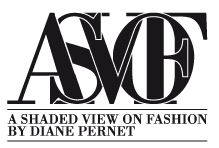Dear Shaded Viewers,
The theatricality of fashion presentations has been part of its history. Schiaparelli showing at midnight at Longchamp, John Galliano for Dior at the Opera Garnier, or Dries van Noten showing his menswear in the gardens of the Palais Royal with the models on bicycles. It’s a continuous theme and some designers embrace the idea, and have strong narratives, others simply select a space and show the clothes. This applies today both for haute couture and ready to wear, and at fashion weeks across the world. It’s especially true often about cruise collections where the location alone is exotic. This January at couture designers chose all sorts of venues as usual and all sorts of stories to enrich their moment in the spotlight.


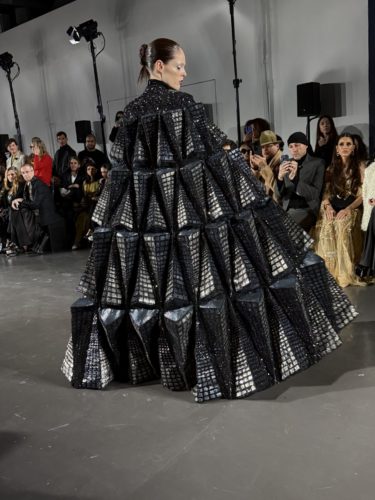
Rahul Mishra has an intelligent and thoughtful approach to fashion, juggling both his cultural background and his concern with the world we live in and how we treat it. His starting point for this seasons couture collection was “The Pale Blue Dot,” a book by American astronomer Carl Sagan, in which he reflected that when viewed from Voyager 1 spacecraft, the earth looked like a tiny insignificant spot.Mishra also recently lost his father, so his inspiration and thoughts behind the creation of this collection merged these two elements, but alongside he was thinking about the hideous severe air pollution of Delhi where he is based. In the past flowers and bees, nature and the insect life, ferns or the beauty in nature have often been the key, with architecture being an element of contrast within his creative themes. In a sense this season mixed many elements and spoke to the audience in two halves, the dark versus the light, indeed one could say pessimism counter balanced by optimism, it also featured bold, amazing casting, something which designers can be nervous about.
The opening part of the show was black and dark and yet still very beautiful, the workrooms and fingers of the ateliers seem capable of realising in three dimensional clothes the impossible. Coco Rocha wore a city of skyscrapers in embroidery and velvet encircling her body, worn over a severe black velvet all in one, and yet it moved and swayed with her procession down the runway space. It is entitled “ The Reverbrating Metropolis” and only a few days later Queen Latifah swept in the stage at The Grammy Awards wearing it. The show progressed through explorations of this skyscraper urban theme with cape effects, slender dresses, a sharp tailored look worn by Agathe Mourin, some bold huge face framing extensions and silver, diamentes, white and crystal decorations on black. The next stage took circles of light in almost a Paco Rabanne or disco manner linking the circles of shine embedded in velvet, like gems in their setting, and created mobile sculptures catching the light. Nature then made its appearance with enchanting black filigree embroidered trailing and winding across black velvet, and onto birds. The birds encircled the wearers who included Jordan Roth who literally took slow flight as the soaring shimmering beaded birds fluttered around him. The final section of the show was opened by Miss Fame in golden embroidery that moved and undulated down the body before breaking in a fringe of fern or leaf shapes flipping at the hem and they walked. More golden looks followed with embroidery, flowers, satin drape and Miss Debra Shaw in a superb golden coat dress. The finale showed clearly these linked passages of the show and gave us a chance to applaud the vision of Rahul Mishra.
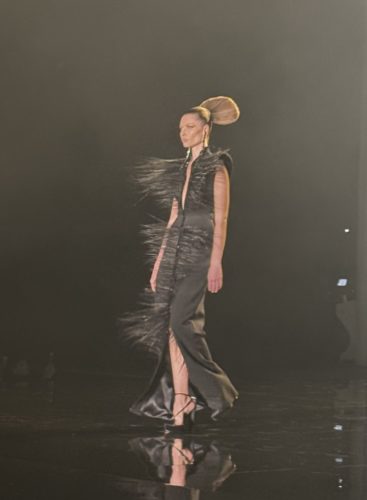

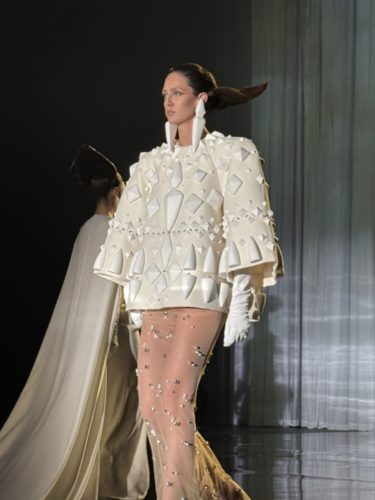
Stéphane Rolland opened his show with an explanation of his charity work with Brigitte Macron which he and his business partner Pierre Martinez forged with the Fondation des Hôpitaux. This is a foundation created in France in 1989 to improve the quality of daily life for children, adolescents and old people hospitalised in France. It was beautifully filmed, and after bows from many of those taking part, but excluding Monsieur Rolland, the lights dimmed, the stage curtains parted, and the show began.
With Josephine Baker as one inspiration and the sculptor Constantin Brancusi as the other the show balanced the linear beauty of the one and the witty elegance of the other. The colours were ivory, blanc cassee, chalk white, and silver plus a series of shades which I can only describe as marron glacé, café au lait, and toast. Soft edible shades of tinted browns? The lines of the pieces were extended with superb hairstyles which made the already tall models in high heels look even more statuesque and proud. Monsieur Rolland empowers women through the splendour of his clothes, with explosions of quill like feathers, huge clouds of weightless gazar, and deep, deep swaying fringes every addition is thoughtful and adds to the strength of the look. Drape across a slender column or elaborate origami like details around a waist appear once, they are never over played and the complex layered hem of one look, or the geometric appliqué shapes on another assume more impact because of this. A huge draped silk mousseline caftan sweeps past and is followed by a contrastive silhouette, and we also see no direct immediately associated fashion looks worn by La Baker, it’s an abstraction of her presence. Finally Coco Rocha does appear like an exotic bird beplumed with explosions of feathers recalling her love of them through her career. By the time the final comes and the applause breaks out, we have been on a journey watching the models climb the long runway and its wide stairs. As the entire company sweep past its magnificent, and epitomises what haute couture can achieve with a designer whose vision enables them to create such magic with a team just for those few minutes. No film or video or snapshot will replace being there, it’s fashion magic.

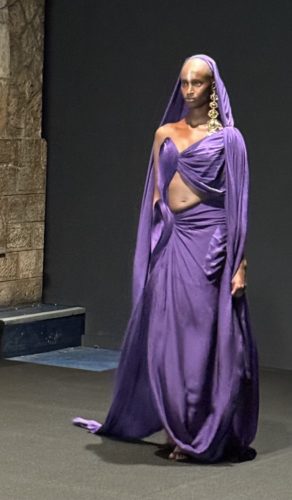

Gaurav Gupta
The night before the show my invitation is hand delivered as are so many across Paris. In an oval box is a weight brass singing bowl and its striker. This hints at what the following mornings first show might hold.
As we arrived the musicians Zen and Sounds were already playing. The classical Indian sounds filled the space and calmed the audience as it assembled, many of us went to see the wall of gongs and instruments ready to be used setting the tone for the show. The actual presentation started with a figure draped and reciting walking slowly through the space; it was Gupta’s partner, the poet and performer Navkirat Sodhi who had been badly burnt in a fire, Gupta’s hand was badly burnt and this is his return after a seasons gap, indeed the collection is entitled “ Across the Flame”. It interprets fire and also the healing of Navkirat across many operations. One dress has a bodice of flames surmounting a black trailing skirt as though the fire has burnt a trail of nothing, a pair of models entwined in flame orange silk jersey are wrapped together as the drapery flickers and flows. We can offer our own reading of intense silver embroidery on black as white heat, or the stunning deep violet purple draped jersey dress as the skin blistering and bruised or the black dress with just a golden thread undulating across the bodice as the fire starting, or even the Tudor blue of the smoke formed into a dress and cloud like effect around the head and shoulders of the model. Although this may sound heavy as a concept because the beauty of the clothes and the extreme level of craft and construction is superb, in the final analysis the narrative can be packed away when analysing the collection. Its beautiful and has some extraordinary pieces within it, and Gaurav Gupta has some signatures of construction and techniques which are special to his creative process, these all appeared. As we leave the venue and make our way from darkness into daylight we hope the terrible journey these two people have made, which we have in a manner witnessed, has been vanquished.
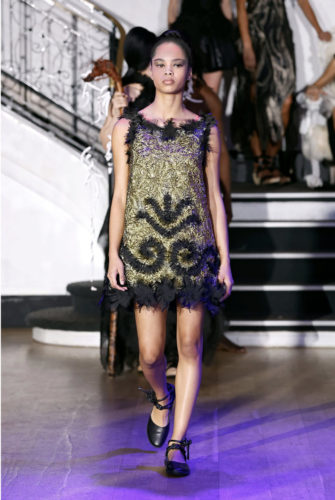
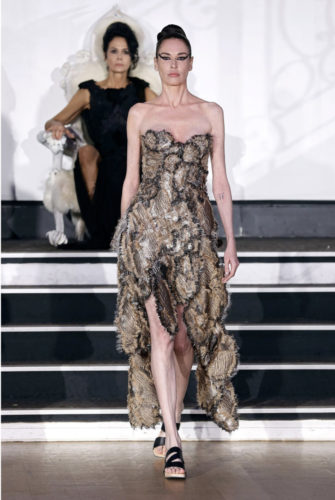
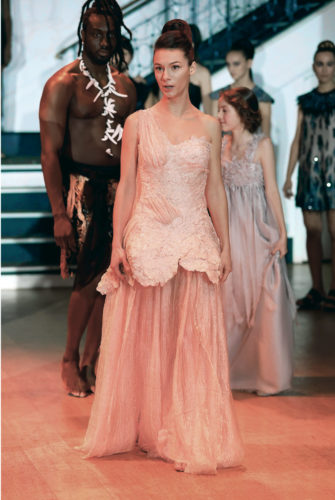
Franck Sorbier is a designer I’ve long followed and long admired, his belief in the hand work of haute couture is embedded in his creativity and integrity.
The room we are ushered into has a double descending staircase from a gallery, so we know it’s been selected for a reason, as the stairs join is a platform and on it a throne like seat. When the show starts a male dancer and female model start the narrative as two more women descend. She claims the throne and he threatens. The weather and the music and the atmosphere is dark and ominous. Later this will change and become springlike, sunny and joyful. The fashion is about the two halves of the collection, the dark and the light, as Monsieur Sorbier says in the programme notes “ Because in the end, it is always Peace that will win.”
The black lace bodice with a long, layered handkerchief point full skirt is beautifully proportioned, the skirt swaying gently like a bell or an inverted flower, the long black dress entirely formed out of hand made fringed “ribbons” of fabric, undulates up and down the body outlining its curves and splits into softness at the hem, another black ribbon type dress is short with an asymmetric panel flipping down, the bodice is of lace and tiny velvet ribbons, threading through to the skirt. The complexity of textures and construction is subtle and is about creating the shapes and surfaces the designer requires. A long line bodice in black lace has a shirt flounce of a skirt in shiny black leather. A man appears in a brilliantly deconstructed tail coat where the tailoring is both finished and exposed, the sleeves removed and the piece has a kind of rock and roll strength. A full length black lace ballgown with the bodice clean and crisp is strapless as a contrast to the complex layered and draped skirt. There are several short almost 1960’s dresses, some in shift shape and all very decorative. The mood shifts and we see young girls in soft pale dresses, alongside them we see a pale silver grey mousseline Empire dress, a blush rose dress with a petal bodice and full gathered skirt or a ivory lace dress with a fitted strapless bodice and a skirt shirt at the front and cascading down at the back to the floor. There’s also a true ballgown in silver and gold looking as if it’s created from leaves, flowers and ribbons. The contrast between the two halves of Symphonie Barbare is very theatrical, and the entire cast assemble in a tableau vivants to great applause. But at the heart are the beautiful pieces, wonderfully hand made in true couture style, and the clearest evidence why, since 2005, a decade ago, Monsieur Sorbier has rightfully been a permanent member of the Federation.
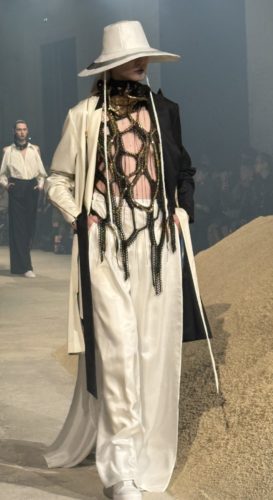
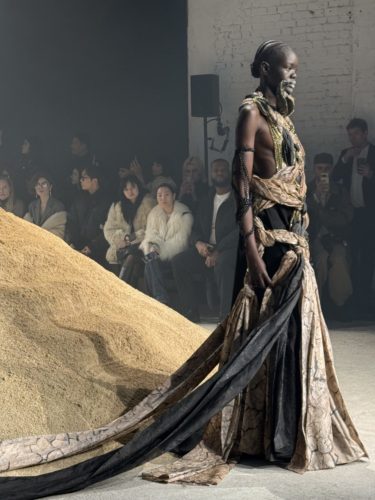

Yuima Nakazato
Across the seasons I watched the experiments in couture this designer has explored and in the last few shows there’s now a definite confidence and strength in his stents and their presentation. This January we were in a triangular corner gallery space which when we entered was blacked out form natural light and with a large sand dune formed of real sand placed in the very middle of the space . Fade was the title of the collection and indeed the softness of fading was present but with the sounds of sea, yet it didn’t feel holiday or hot, it felt more like an oasis. The clothes were truly lovely with layers and a kind of ritualistic or ceremonial feeling to the collection. The lightness and weightlessness of the pieces meant they swayed or in some cases billowed or drifted in the air, the overlayers often placed in the looks were cutwork, macrame and crochet or simply somehow assembled in a distorted lattice sometimes with gold or metallic shine added. This ornamental and the very plain were worked together with once or twice huge veils clouding out from the model. The complex fabric layers and the long languid lines heralded the models as citizens of a remote tribe or time, a buried city inhabitants whose tunics, jackets, trousers, dresses were not like anything we would normally see. There was an oddness and yet a beauty to the show, pieces were wrapped and tied, encircling the body, genderless, seasonless and timeless, they walked past in a long coat over trellis over wide wide pants, or a gilet suspended over trellis over a panelled skirt, or a long slender la e knit sweater dipped in shades of blue with simple palazzo pants or marbled silk organza draped and trailing, or a long ivory dress with no back. Nakazato invents and creates in a truly innovative manner and uses couture to showcase his ideas. It’s a fantasy or vision made real, and we get to watch. Finally he walked slowly up the dune where he started digging with his bare hands, he carefully pulled out a robe made of hundreds of pieces, it was apparently ceramic, and now he was joined by a tall model dark gold trousers and gilet. The designer not only dressed him in the robe but fastened it all down the back and arranged the hugely weighty piece so that after he exited the model walked forward down the dune to herald the finale of the show. Truly an event, and a wonderful example of where fashion at couture might take us if we explore and experiment outside the usual, the normal or the conventional.



Sara Chraibi
The Institute du Monde Arabe 1988 has dealt well with time since its architectural strength has great integrity. To show here Maison Sara Chraibi is on the top floor in a space where there extraordinary metal Mashrabiya windows work like camera apertures, they open when dark and close when bright. In many shots from the show they provide the background and this is as it should be. This Moroccan designer celebrates her North African and cultural roots, threading them through her work and offering creative elements acknowledging many different facets of her background. This season the hair was wonderfully parted, plaited and worked on many of the models and often descended onto the garments and sometimes had large ear decorations as well. They parade was almost rhythmic and slightly ritualistic in its pacing as each model walked past. Oddly it reminded me a little of Georgian dancers, and they seems like high priestesses air leaders of some enclave in their power and confidence. Nature seems to be a very strong theme with seas and waves, skeletal trees and branches, leaves and flowers all appearing in different forms from fabric patterns to embroidery to lace. Trousers and capes, jackets and long dresses, overlayers in sheer fabrics, intricate lace over sheer, or soft djellaba shapes layered the collection but in the lightest way imaginable. White on white , mother of pearl, a deep indigo, a silvery grey, pewter, were amongst the colours, whilst fringe, trails of leaves, long split and simple lines gave more movement as the procession passed. As far as silhouettes are concerned I imagine that in the salon, as each piece is shown separately the clients with layer and select from the complete range, not just the looks shown, since there were so many variations from slim and waisted to long and flowing, from lightly tailored to draped. It’s a collection of depth and beauty and it certainly cast a spell, if I had to use one word to sum it up I think enchanting would be the one.

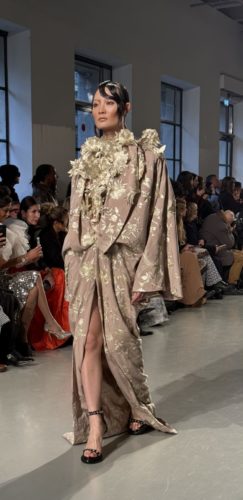

Juana Martin
As an Andalusian Juana Martin’s heritage, culture and inspirations are vital to her work. This season Estrella Morente and live musicians provided the soundtrack to the show, setting it firmly in context. The power of the Granada born flamenco singer was also her engagement with the show, slicing and sweeping her fan through the air. Flinging her trailing black mousseline dress scattered with dark red shiny rose petals behind her with expertise.
Spain has produced great fashion of course, with Cristobal Balenciaga still the couture is on for many. Madame Martin several times touched on tradition that he also loved, the fit and flare silhouette of flamenco dancers, also their ruffles, the black lace of mantillas and shawls, the volume of weightless gazar, and of course black as a cloud not a fashion statement. There’s no copying or referencing the great man, it’s about cultural heritage and how a designer never truly shed, and why should they their background or roots. The show has some really beautiful looks in it, I start by mentioning three looks in a copper chestnut shade, the first a pants suit in heavily slubbed silk shantung with a swathe of crushed folds encircling the shoulders, then there was a long mousseline top and long trailing skirt with the hem of the tunic weighted down by whirling plisse frills in taffeta, and finally a strapless mousseline dress with the entire empire bodice formed of taffeta frills plus a very long stole trailing around the head and shoulders in the taffeta. The beige coat draped like a huge kimono or caftan shape was embroidered with an amazing 18th century pattern of birds and foliage, whilst the ivory white satin sheath dress was a miracle. The long slender shape had wired “branches” curving out of the bodice weighted down with deep ivory beaded fringe, it was like a couture palm tree and the technique to make this work without the branches moving around and the whole to look so perfect and effortless was a true example of how couture can solve problems and create beauty. The entire show was a real show, with golden flower cages and monumental shapes as well as more practical fashion ideas. When Senorita Morente led the final singing her heart out, the audience was in raptures. Brava.
Later,
Tony Glenville
